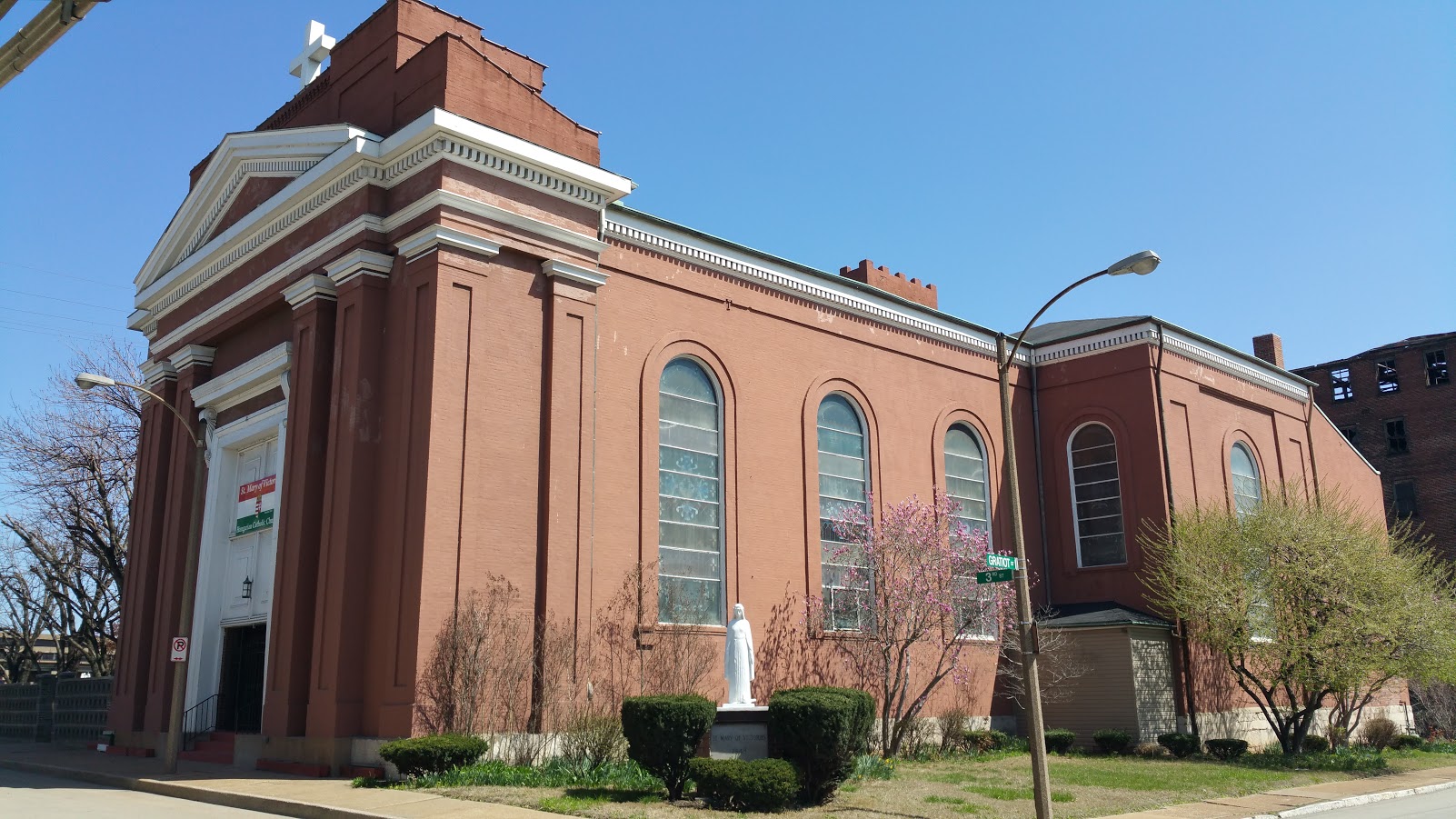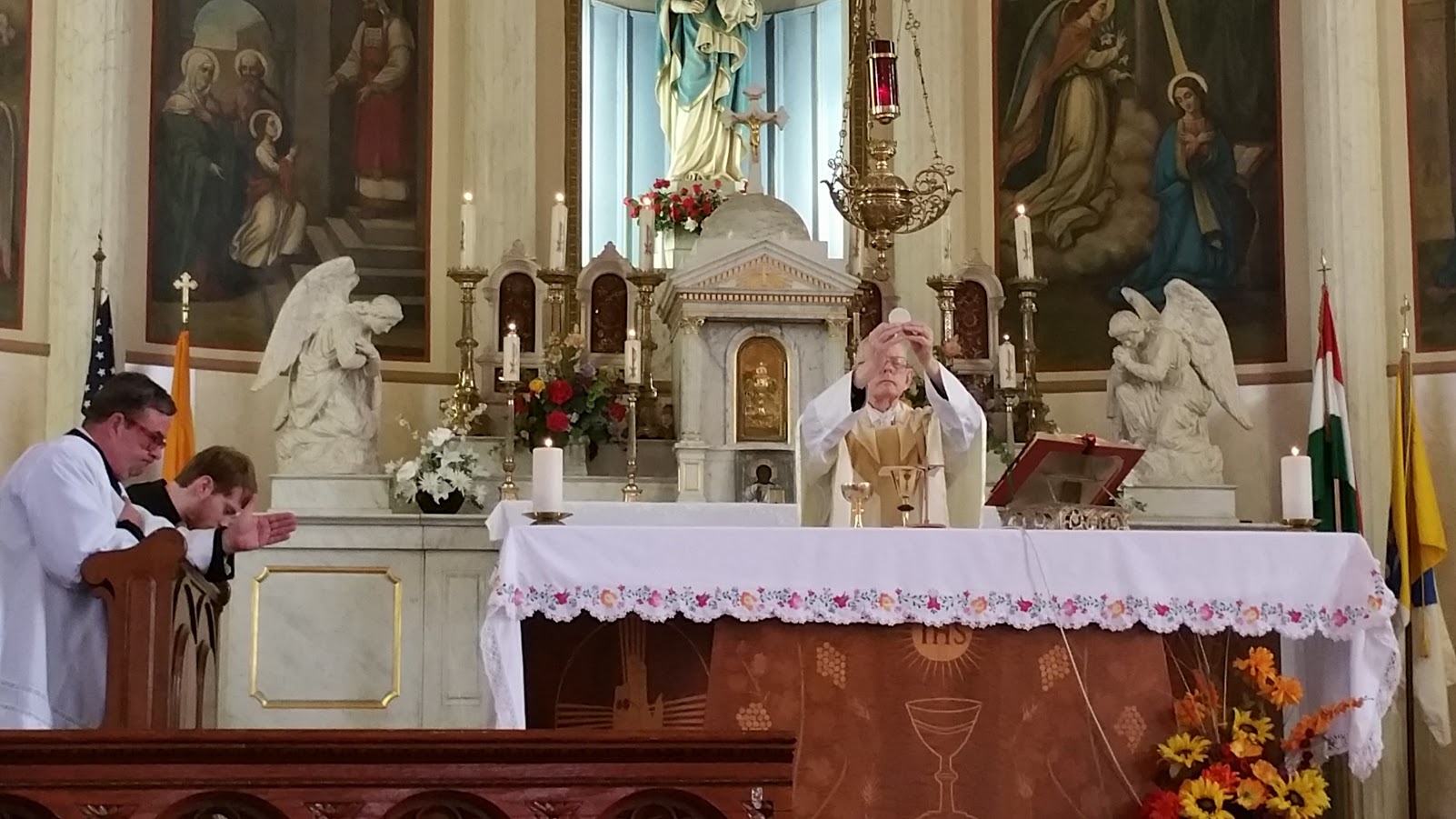Many of the texts in today's original Gregorian formulary are taken from an ancient formulary for the Dedication of a Church, because in the fifth century the dedication of a church in honor of St. Michael was celebrated at Rome on September 30 (later the 29th), and the chants for that day were later transferred to a nearby Sunday. We don't know exactly when that occurred. In very early times this Sunday followed immediately upon the autumnal Ember Days; since the services of Ember Saturday were prolonged throughout the night till morning, the day did not have a Mass proper to it, whence the borrowing. So the Introit and the psalm-verse Laetatus sum. . . have us enter the house of the Lord; the Gradual with the words of the same psalm and the Offertory treat of the altar and the sacrifice; the Communion (now Year A only in the OF) urges us to bring our sacrificial gifts and to offer our worship in God's house.
Introit: Da pacem
Offertory: Sanctificavit Moyses
Offertory: O Jesus we adore thee, p. 305
(Year A) Communion: Tollite
Mass XI, PBC p. 58. Credo III, PBC p. 77
This Introit is also the Introit of the Votive Mass for Peace, which is traditionally sung on the second day of the Forty Hours Devotion (the US adaption of the popular Quarant' Ore). From this usage, it became one of the more widely known antiphons of the Gregorian repertoire. It has three phrases; in the third phrase the melody conveniently allows for a quick break after servi tui.
-
Da pacem Domine sustinentibus te
-
ut prophetae tuae fideles inveniantur
-
(a) exaudi preces servi tui
(b) et plebis tuae Israel
The first phrase is reminiscent of the Introit Rorate caeli, and the two are closely allied in spirit. Identical with it is the first phrase of the well-known Introit Statuit. The continual use of b♭ in the first and second phrases tends to make the melody tender and devout, while the frequent repetition of the same motif or of a similar one makes it impressive. This motif is composed of the notes ab♭gag over (Do)-mine, which remains the same in its first part, but changes slightly in its second over susti-(nentibus), tui, preces, tuae. It produces its greatest effect over tuae, because it sets in here with a major third, while in the other cases only a whole step precedes.
The Offertory has five phrases:
-
Sanctificavit Moyses altare Domino
-
offerens super illud holoholocausta,
-
et immolans victimas
-
fecit sacrificium vespertinum in odorem suavitatis Domino Deo
-
in conspectus filiorum Israel.
According to the context, the present participles offerens and immolans are closely related. A great caesura, however, is introduced into the melody by the cadence over (holo)-causta, and further on prominence is given to et immolans which is hard for us to grasp. Similarly, in relation to the other phrases, the third receives undue amplification. Here we cannot apply as a measure of perfection the carefully planned and artistic development which we so admire, for instance, in Graduals of the fifth mode. In spite of this, however, the melody has beauties of its own.
The first word is simply narrative, confines itself to a tetrachord (f-b). What we now feel to be a bright major chord, we hear over altare and odorem and in a descending line over (con)-spe-(ctu). The soothing close of (Do)-mino echoes somewhat over (vic)-timas, (vesper)-tinum, and Deo. To the descending fourths at the beginning and end of the second phrase, the strongly accented ascending fourth over (ho)-lo-(causta) comes as an answer. Over illud two bistrophas are sung after the clivis, followed by an accented torculus. The third phrase is introduced like Moyses above. (Suavi)-tatis resembles (holo)-causta; Do-(mino) repeats the first four notes of the last-mentioned word. The fourth phrase abounds with groups of neumes and in its lower part brings a delightful new movement.
It is extremely rare in plainsong that a melody closes on the leading note f g ef gg f. Is this descent of the melody to signify the deep impression which the sacrifice of Moses made upon the Israelites? God had given His law upon Mount Sinai. The sacrifice was now to ratify the covenant which God had made with His people. The New Testament has been sealed in like manner by bloody sacrifice, by an evening (vespertinum) oblation, for it was about the ninth hour when Jesus bowed His head on the Cross and gave up the ghost. This sacrifice is renewed at Mass. What a high consecration (sanctificavit) attaches to the altars of our churches! How sublime the Sacrifice that is offered upon them! With what pleasure does not our heavenly Father regard it! Then is fulfilled what the priest asks for at the offering of the chalice—it ascends with the savor of sweetness. And we, the new Israel, are allowed to be witnesses (in conspectu) of this mystery. What is more, we ourselves are drawn into the mystery. We become, as the liturgy so often reminds us, partakers of the one supreme Godhead.
(Year A) The Communion antiphon has only two phrases:
-
Tollite hostias, et introite in atria ejus
-
adorate Dominum in aula sancta ejus
The connection of this text with its former place in a Dedication formulary is obvious. On this Sunday, it makes a connection particularly with the first reading and the melody links together the three imperative verbs: tollite, introite, and adorate. Tollite and introite have the same note progression, deb, and consequently they are also closely related melodically. Hostias towers above both these words. The third one, adorate, never extends beyond c and the modest interval of a minor third. The solemnly descending line in the second phrase expresses the idea of adoration—a profound bow, a prostration before the majesty of God. In the annotated manuscripts each of the clives over the words (ado)-rate Dominum is marked with a hold, thus enhancing the impression of reverence. But the solemn spirit is made less formidable by the fact that each new clivis opens on the same note with which the preceding closed. In the church our humble gifts of bread and wine are converted into the Loud Himself; under the sacred species we adore Him who offers Himself for us and gives Himself to us in Holy Communion. In aula is related to ejus of the first phrase. It closes on b♭ like the second ejus, while sancta closes on c. Instead of the quiet, solemn two-note groups of the preceding member, we here have three-note groups. The suspended close on b♭ may serve to remind us that we are still awaiting the eternal courts of God, the eternal liturgy of heaven. With one exception, the accented syllable is always higher than the following syllable.


















